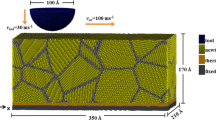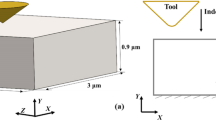Abstract
Context
The mechanical characteristics and deformation behavior of Cu material under the nanoscratching through a diamond tooltip on the workpiece are studied using molecular dynamics (MD) simulation. Effects of scratching velocity, scratching depth, workpiece temperature, and grain size on the total force, shear strain, pile-up, shear stress, workpiece temperature, and phase transformation are investigated. The results reveal that increasing the scratching velocity leads to higher oscillation in total force, greater shear strain and shear stress, higher pile-up on the workpiece surface, and higher workpiece temperatures. The effect of the scratching velocity on phase transformation shows that most of the dislocation is a transformation structure from the FCC structure to the HCP, BCC, and other structures in all workpieces during the nanoscratching process. In addition, with increasing the scratching depth, material pile-up becomes more prominent, consequently elevating the contact area between the diamond tooltip and the workpiece, which simultaneously leads to an increase in total force, shear strain, pile-up, shear stress, and workpiece temperature. The MD simulation results revealed that the subsurface region of nanoscratched Cu single-crystal experiences the formation of stacking faults, vacancy defects, and cluster vacancies. In studying the effect of workpiece temperature, the results show that higher temperatures lead to the decline of scratching force, high plastic deformation, increased shear strain and stress, lower pile-up height, and high transition from the FCC structure to both other and BCC structures. For polycrystalline structures, the force curves occur in the oscillation state in all cases of different grain sizes because of the dislocation deformation during the cutting process. The maximum force decreases with diminishing grain size, attributed to the inverse Hall-Petch relation. As the grain size increases, leading to a decrease in the shear strain, stress, and an uneven pile up; also, the HCP structure rises with decreasing grain boundary and the partial dislocation and stacking fault mobilize inside grains.
Methods
By using molecular dynamics (MD) simulation based on the Large-scale Atomic/Molecular Massively Parallel Simulator (LAMMPS) software, all molecular interactions were described by the Lennard-Jones (LJ) and embedded atom method (EAM) potentials. In order to mitigate the effects of temperature fluctuations, the system employs an isothermal and isobaric (NPT) ensemble for precise temperature control. The temperature was set as 300 K and the time step was 1 fs (femtosecond).
















Similar content being viewed by others

Data availability
The datasets used and/or analyzed during the current study are available from the corresponding author upon reasonable request. Correspondence and requests for materials should be addressed to Te-Hua Fang
References
Wu Y, Huang H, Zou J (2011) Transmission electron microscopy characterization of the deformation of CdZnTe single crystals induced by nanoscratching. Scr Mater 65(5):392–395
Wu Y, Huang H, Zou J, Zhang L, Dell JM (2010) Nanoscratch-induced phase transformation of monocrystalline Si. Scr Mater 63(8):847–850
Sumigawa T, Shishido T, Murakami T, Iwasaki T, Kitamura T (2010) Evaluation on plastic deformation property of copper nano-film by nano-scale cantilever specimen. Thin Solid Films 518(21):6040–6047
Wang W et al (2022) Molecular dynamics simulation of deformation mechanism of CoCrNi medium entropy alloy during nanoscratching. Comput Mater Sci 203:111085
Chavoshi SZ, Xu S (2018) A review on micro- and nanoscratching/tribology at high temperatures: instrumentation and experimentation. J Mater Eng Perform 27(8):3844–3858
Rigney DA, Hirth JP (1979) Plastic deformation and sliding friction of metals. Wear 53(2):345–370
Wang Q, Bai Q, Chen J, Sun Y, Guo Y, Liang Y (2015) Subsurface defects structural evolution in nano-cutting of single crystal copper. Appl Surf Sci 344:38–46
Zhang J, Wei Y, Sun T, Hartmaier A, Yan Y, Li X (2012) Twin boundary spacing-dependent friction in nanotwinned copper. Phys Rev B 85(5):054109
Wang Q, Bai Q, Chen J, Guo Y, Xie W (2015) Stress-induced formation mechanism of stacking fault tetrahedra in nano-cutting of single crystal copper. Appl Surf Sci 355:1153–1160
Zhu J, Zhou Q, Huang Y, Zhou B, Wang J (2021) Surface deformation of single crystalline copper on different nano-scratching paths. J Mater Sci 56:10640–10652
Shi J, Fang L, Sun K, Peng W, Ghen J, Zhang M (2020) Surface removal of a copper thin film in an ultrathin water environment by a molecular dynamics study. Friction 8(2):323–334
Li J, Fang Q, Liu Y, Zhang L (2015) Scratching of copper with rough surfaces conducted by diamond tip simulated using molecular dynamics. Int J Adv Manuf Technol 77(5):1057–1070
Wang Q, Bai Q, Chen J, Su H, Wang Z, Xie W (2015) Influence of cutting parameters on the depth of subsurface deformed layer in nano-cutting process of single crystal copper. Nanoscale Res Lett 10:1–8
Zhu P, Fang F (2016) Study of the minimum depth of material removal in nanoscale mechanical machining of single crystalline copper. Comput Mater Sci 118:192–202
Chien CH, Wang CT, Tsai CH, Yang PF, Lu YX, Chen B-S (2016) Temperature effect on kinetic friction characteristics of Cu substrate composed by single crystal and polycrystalline structures. Comput Mater Sci 117:412–421
Guo Y, Liang Y, Chen M, Bai Q, Lu L (2010) Molecular dynamics simulations of thermal effects in nanometric cutting process. Sci China Technol Sci 53:870–874
Bolesta AV, Fomin VM (2014) Molecular dynamics simulation of polycrystalline copper. J Appl Mech Tech Phys 55:800–811
Liu H, Hao M, Tao M, Sun Y, Xie W (2019) Molecular dynamics simulation of dislocation evolution and surface mechanical properties on polycrystalline copper. Appl Phys A 125:1–13
Ma Y, Zhang S, Xu Y, Liu X, Luo S-N (2020) Effects of temperature and grain size on deformation of polycrystalline copper–graphene nanolayered composites. Phys Chem Chem Phys 22(8):4741–4748
Wang Z et al (2019) The interaction between grain boundary and tool geometry in nanocutting of a bi-crystal copper. Int J Extreme Manuf 1(4):045001
Chamani M, Farrahi GH, Movahhedy MR (2017) Friction behavior of nanocrystalline nickel near the Hall-Petch breakdown. Tribol Int 107:18–24
Plimpton S (1995) Fast parallel algorithms for short-range molecular dynamics. J Comput Phys 117(1):1–19
Thompson AP et al (2022) LAMMPS-a flexible simulation tool for particle-based materials modeling at the atomic, meso, and continuum scales. Comput Phys Commun 271:108171
Stukowski A (2009) Visualization and analysis of atomistic simulation data with OVITO–the open visualization tool. Model Simul Mater Sci Eng 18(1):015012
Korchuganov AV, Zolnikov KP, Kryzhevich DS (2019) Atomic mechanisms of stacking fault propagation in copper crystallite. Mater Lett 252:194–197
Zhu P-z, Y-z H, Ma T-b, Wang H (2010) Study of AFM-based nanometric cutting process using molecular dynamics. Appl Surf Sci 256(23):7160–7165
Jian-Hao C, Qiu-Yang Z, Zhen-Yu Z, Cong D, Zhong-Yu P (2021) Molecular dynamics simulation of monocrystalline copper nano-scratch process under the excitation of ultrasonic vibration. Mater Res Express 8(4):046507
Oluwajobi A, Chen X (2012) The effect of the variation of velocity on the molecular dynamics simulation of nanomachining. 18th International Conference on Automation and Computing (ICAC). IEEE, pp 1–6
Doan D-Q, Fang T-H, Chen T-H (2020) Influences of grain size and temperature on tribological characteristics of CuAlNi alloys under nanoindentation and nanoscratch. Int J Mech Sci 185:105865
Varga M, Leroch S, Eder SJ, Rojacz H, Ripoll MR (2019) Influence of velocity on high-temperature fundamental abrasive contact: a numerical and experimental approach. Wear 426:370–377
Yamakov V, Wolf D, Phillpot S, Gleiter H (2003) Dislocation–dislocation and dislocation–twin reactions in nanocrystalline Al by molecular dynamics simulation. Acta Mater 51(14):4135–4147
Zhu P-z, Y-z H, Ma T-b, Wang H (2011) Molecular dynamics study on friction due to ploughing and adhesion in nanometric scratching process. Tribol. Lett 41(1):41–46
Efe M et al (2021) Nanomechanical scratching induced local shear deformation and microstructural evolution in single crystal copper. Appl Surf Sci 562:150132
Pei QX, Lu C, Lee HP (2007) Large scale molecular dynamics study of nanometric machining of copper. Comput Mater Sci 41(2):177–185
Naik SN, Walley SM (2020) The Hall–Petch and inverse Hall–Petch relations and the hardness of nanocrystalline metals. J Mater Sci 55(7):2661–2681
Nguyen V-T, Fang T-H (2021) Phase transformation and subsurface damage formation in the ultrafine machining process of a diamond substrate through atomistic simulation. Sci Rep 11(1):17795
Doan D-Q, Fang T-H, Chen T-H (2022) Nanomachining characteristics of textured polycrystalline NiFeCo alloy using molecular dynamics. J Manuf Process 74:423–440
Li J, Liu B, Luo H, Fang Q, Liu Y, Liu Y (2016) A molecular dynamics investigation into plastic deformation mechanism of nanocrystalline copper for different nanoscratching rates. Comput Mater Sci 118:66–76
Xu Y et al (2019) A molecular dynamic study of nano-grinding of a monocrystalline copper-silicon substrate. Appl Surf Sci 493:933–947
Nazemian M, Chamani M (2019) Experimental investigation and finite element simulation of the effect of surface roughness on nanoscratch testing. J Mech Sci 33(5):2331–2338
Funding
The authors acknowledge the support by the Ministry of Science and Technology, Taiwan under grant no. NSTC 111-2221-E-992-037-MY3 and NSTC 110-2221-992-009-MY3.
Author information
Authors and Affiliations
Contributions
Thi-Thuy Binh Ngo: formal analysis, investigation, software, writing—original draft, visualization, conceptualization, writing—review and editing. Te-Hua Fang: data curation, funding acquisition, methodology, project administration, resources, validation. Van-Thuc Nguyen: visualization, conceptualization, writing—review and editing.
Corresponding author
Ethics declarations
Competing interests
The authors declare no competing interests.
Additional information
Publisher’s note
Springer Nature remains neutral with regard to jurisdictional claims in published maps and institutional affiliations.
Rights and permissions
Springer Nature or its licensor (e.g. a society or other partner) holds exclusive rights to this article under a publishing agreement with the author(s) or other rightsholder(s); author self-archiving of the accepted manuscript version of this article is solely governed by the terms of such publishing agreement and applicable law.
About this article
Cite this article
Ngo, TT.B., Nguyen, VT. & Fang, TH. Nanoscale friction behavior and deformation during copper chemical mechanical polishing process. J Mol Model 29, 293 (2023). https://doi.org/10.1007/s00894-023-05699-x
Received:
Accepted:
Published:
DOI: https://doi.org/10.1007/s00894-023-05699-x



